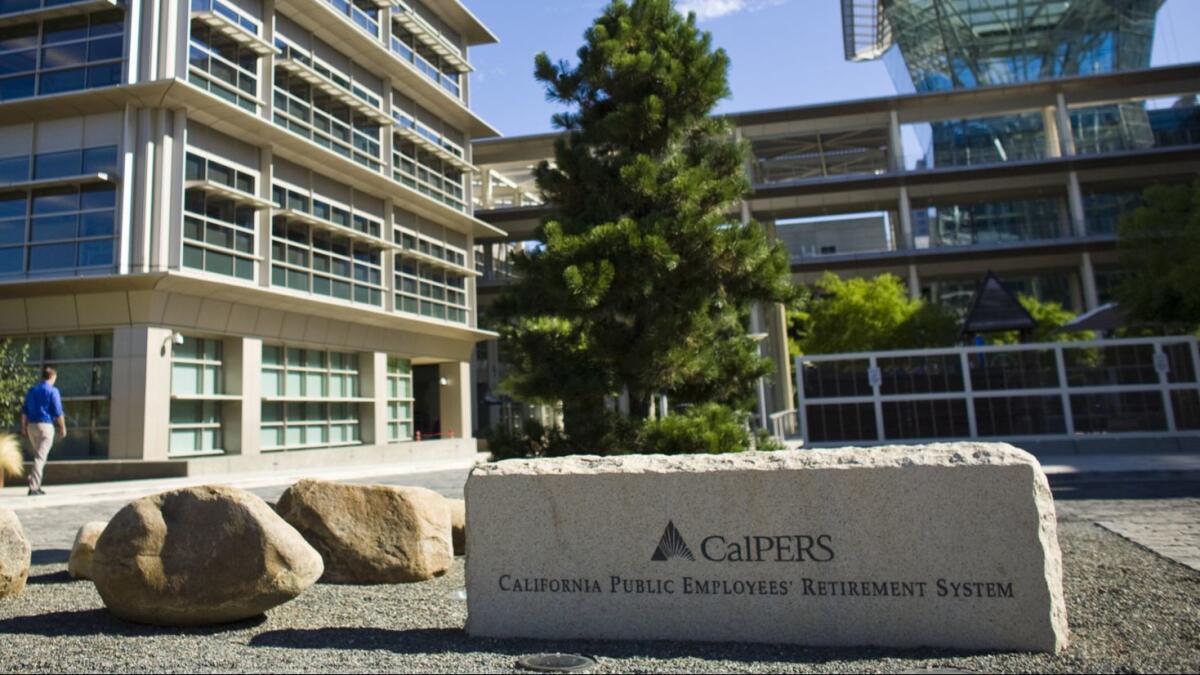Column: Questions about new CalPERS CFO’s background and experience should be taken seriously by the pension fund

The California Public Employees’ Retirement System is the largest public pension fund in the country, with more than $350 billion in assets.
CalPERS serves 1.9 million workers in its pension system and provides health coverage to 1.4 million workers and their families. The system long has been known as a bellwether and standard-setter among institutional investors.
Now meet its chief financial officer, Charles A. Asubonten, who was appointed in September. Asubonten doesn’t appear to have much experience in the pension finance field. According to the 55-year-old’s resume, his most significant recent employment before joining CalPERS was in 2006 through 2009, when he served as CFO of a South African copper mining company that earned about $23.5 million profit on revenue of about $483 million in 2009. After that, he went through a more than yearlong period of unemployment.
We thought Charles would be an excellent candidate, and over the last five months that has proven to be exactly true.
— CalPERS CEO Marcie Frost, on CFO Charles Asubonten.
In announcing Asubonten’s appointment, CalPERS said that “most recently, he was the managing director in a private equity firm,” even though his actual activities don’t match how those terms are commonly understood. The CalPERS job pays a base salary of $275,000.
It’s possible that Asubonten is as talented as CalPERS believes, in which case it should be commended for finding a good CFO where other such organizations failed to look. But there are enough questions about Asubonten’s background and experience to warrant further examination.
Some of those questions have been raised in recent days by Susan Webber, a management consultant and financial blogger who posts at nakedcapitalism.com under the pen name Yves Smith.
Queried by Webber, Asubonten dismissed her questions as “character assassination,” an assertion later repeated to me by a CalPERS spokesman.
That won’t do. These questions, and many others raised by Webber, are legitimate. CalPERS needs to confront them directly and in detail — for its own credibility and the welfare of its members.
In a telephone interview, CalPERS Chief Executive Marcie Frost delivered an unqualified vote of support for Asubonten, who was also on the call. She cited his “ability to look at the finances of an organization and really embed financial thinking into every single decision. That was why we thought Charles would be an excellent candidate, and over the last five months that has proven to be exactly true.”
Asubonten said during the interview that “nothing on my resume is exaggerated; there is no discrepancy.” He said the employment gap on his resume covered a period in which he was working with a consortium on an ultimately unsuccessful effort to buy the copper mining company.
The job of chief financial officer has been something of an albatross for CalPERS. The organization only created the post in 2011 to “coordinate risk management.” Its first CFO was Cheryl Eason, who started in November 2012 and had been an executive at the British Columbia Pension Corp., a leading Canadian pension fund.
After Eason left CalPERS to take an academic position in Canada, the system hired the professional headhunting firm Heidrick & Struggles to find a replacement, and eventually offered the position to Richard Gillihan, who was the state human resources director and an ex officio member of the CalPERS board.
But Gillihan withdrew before starting the job because of questions over whether his HR post made him ineligible for the CalPERS job. CalPERS resumed the search with an internal committee, which settled on Asubonten. He had been on the list of candidates considered by Heidrick & Struggles, but it isn’t clear how closely the firm examined him or whether it even interviewed him in the first round.
What CalPERS was looking for, according to its recruitment brochure for the position, was someone who had “worked in sophisticated and complex businesses with a specific focus on large pension funds, global financial institutions, asset managers, and other diversified financial services companies.”
That brings us back to Asubonten. A certified public accountant, he holds a bachelor’s degree from North Carolina Central University and an MBA from the University of Michigan. According to his resume, after brief stints at the accounting firm KPMG and Dow Chemical, he joined Ford Motor Co. as a financial analyst. Later he moved to DTE Energy, a Detroit electric generating utility, serving in various financial positions from 1998 through 2006.
In 2006, Asubonten moved to South Africa, where he was assigned by the Australian-British mining company Rio Tinto to work as CFO of its copper mining subsidiary, Palabora Mining.
“I was hired to help with their turnaround,” he says. “The company was in dire straits.” He says he came up with a recovery strategy “and quickly things turned around.”
Asubonten’s resume boasts that he “drove results which saw the share price move from 20’s to over 100 rand in 3 years” at Palabora. That sort of claim warrants close scrutiny, in part because share prices are subject to so many influences that the impact of a single middle-level manager is usually diluted.
Asubonten’s description of the trajectory of Palabora stock is misleading. When he arrived in July 2006, the stock was trading in the 40s, not the 20s. It never closed below the mid-30s as long as he was there. Though it’s true that the stock reached a peak of 160 rand in late June 2008, it fell back to the 40s by the following March before rising again.
The logical explanation is that Palabora shares didn’t trade based on the company’s internal health, but on the price of its product, copper.
When copper prices rose or remained firm, as they did in early 2008 and through 2009, Palabora shares did well. When copper prices crashed, as they did in late 2008, Palabora shares got crushed. How much credit can Asubonten claim for this? You be the judge.
About a year after leaving Palabora, according to his resume, Asubonten took a job as CFO of a Zambian mining company, working there from May 2012 to June 2013. Then came his reported involvement in a “private equity firm.” The reference is to Transmax, a firm where Asubonten says he served as “managing director” starting in June 2013.
The address listed for Transmax on Asubonten’s Form 700, a disclosure form required of all state officials, is not a business address but a mail drop, as Asubonten confirmed to me. The address is a strip mall outside Baltimore.
As Webber observed, Transmax isn’t registered in Maryland, and Asubonten acknowledged it’s not registered with the Securities and Exchange Commission. The reason, he says, is that it did not raise capital in the United States. Asubonten told me he “advised people who raised funds on their own. But I had nothing to do with that.” Asked how big Transmax was, he told me, “That is something I do not choose to discuss.”
Given these facts, how could CalPERS describe Asubonten as “the managing director in a private equity firm”? That phrase denotes someone who is actively engaged in the management of a firm that collects investments from institutions and individuals and deploys it to assemble a portfolio of private businesses, which it helps to manage or prepare for resale.
That’s not how Asubonten described his activities. Indeed, for all we know, “managing director” is a title he could have bestowed upon himself — “As a CPA, I could start a firm tomorrow, and I would be the managing partner of the firm,” he said.
Frost explained that her understanding is that Transmax was “a consulting firm and it consulted with international companies who wanted to do private equity deals, and Charles was the managing director who was providing that kind of consultation…. So he was the managing director in his firm but the service he was providing was professional consulting services.”
Asubonten dismissed this issue as one of “semantics,” but it’s more serious than that. If CalPERS were a public company that described a top executive’s background so loosely, it’s possible that the SEC would question the disclosure.
I’d suggest the CalPERS board take a closer look at Asubonten’s qualifications, except that in recent years the board has shown itself to be one of our less impressive public bodies. Just a year ago, as I reported, the board was bogged down in intramural bickering and attacks on one of its most tough-minded members, J.J. Jelincic.
As recently as last month, this behavior surfaced again, when board President Priya Mathur locked board member Margaret Brown out of CalPERS premises over what appeared to be a minor infraction. Moreover, according to a letter sent to Mathur on Friday by James Moody, an attorney for Brown, and reported by Webber, Mathur or CalPERS staff under her direction have been diverting mail addressed to Brown at CalPERS — and apparently to other board members as well — and in at least some cases not sharing its contents with the addressee. A CalPERS staff member informed Brown that “Priya reviews all correspondence addressed to board members and directs how to proceed.” (Mathur, by the way, was stripped of her board posts for a time in 2014 over her violations of state political ethics laws.)
All this suggests that the CalPERS board members need to be given something serious to work on so they have less time to act childishly. A good place to start would be to inquire just how one of the system’s most important executives was recruited and hired, and whether he’s everything his CEO says he is.
Keep up to date with Michael Hiltzik. Follow @hiltzikm on Twitter, see his Facebook page, or email [email protected].
Return to Michael Hiltzik’s blog.
UPDATES:
10:44 a.m.: This post has been updated with accusations that Priya Mathur has been diverting CalPERS board members’ mail.
More to Read
Inside the business of entertainment
The Wide Shot brings you news, analysis and insights on everything from streaming wars to production — and what it all means for the future.
You may occasionally receive promotional content from the Los Angeles Times.











